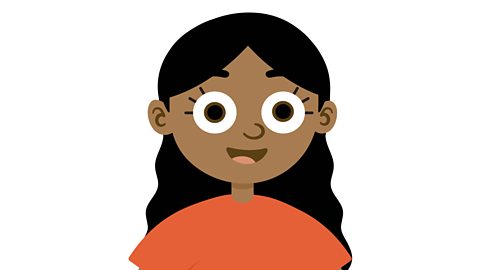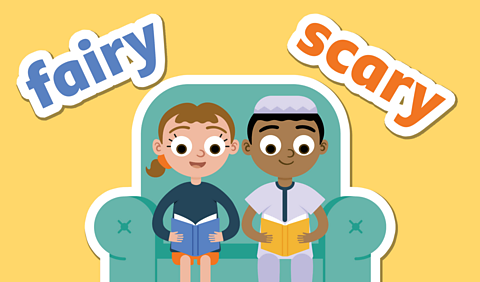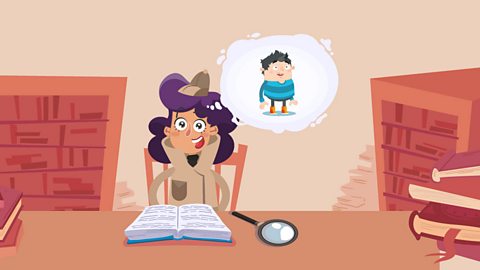What is a syllable?

A syllable is a beat of sound in a word.
The beat can sometimes be part of a word, or the whole word.
For example, the word 'window' has two beats ('win' – 'dow') but the word 'door' had just one ('door').
Breaking words down into their syllables can be really helpful when you are learning spellings.

Watch: Syllables
Watch this short video to hear some examples of syllables and learn how to count them.
Discover what a syllable is and hear some examples.
[MUSIC]
MR FIRTH
Hello, I’m Mr Firth and today we’re going to be focusing on words that have one or more syllables in them. But first, let’s remind ourselves what a syllable is.
A syllable is a beat of sound in a word. It can sometimes be part of a word, or it can be the whole word. Let’s start with colours.
We’re going to show you various colourful words to see how many syllables are in each word.
Here’s a handy tip too. Sometimes It helps to clap to keep counts of how many syllables a word has.
Let’s begin.
Blue. How many syllables does the word ‘blue’ have? The answer is one syllable.
BLUE.
Let’s try another. How about orange? How many syllables can you count in the word ‘orange’?
The answer is two? O and RANGE. So two beats in a word means two syllables!
Now it’s your turn to try. I’m going to say the name of some animals and I want you to clap how many syllables are in each word.
This is Sammy the snake. Let’s say the word ‘snake’ together and clap on each beat of the word. Ready? Here it goes.
Snake.
Can you tell how many syllables there are?
That’s right. There’s only one syllable in ‘snake’.
Let’s-s-s-s move away from Sammy the snake and find another animal.
Here’s a friendly parrot. Can you work out how many syllables are in the word ‘parrot’? Let’s clap together and find out, in three, two, one…
PAR ROT.
That’s two claps, meaning the word ‘parrot’ has two syllables in it. Thanks, parrot!
Great work! Now we know what a syllable is, let’s try out some harder words. Remember to clap each time you say a beat of a word, just like this…
SYL-LAB-LES.
Let’s go.
Here’s our first word. Yeah, you got it. The word is “elephant”. So let’s say each syllable with a clap.
So syllable one is EL.
Syllable two is E.
And the third syllable is PHANT.
All together now! EL E PHANT.
How many syllables did you count? That’s right, there are three syllables in the word ‘elephant’. That’s excellent work!
Let’s do another just to test you, this time with a more difficult word.
Recognise this animal? That’s right, it’s a hippopotamus. Now, I want you to write down the word ‘hippopotamus’ and try to work out how many syllables there are.
Remember, say the word slowly and clap on each beat to get the correct answer. Are you ready? Say out loud each syllable and work out how many syllables you think there are. How many did you guess? Well, let’s see now with our clapping technique.
HI PPO POT A MUS
How many syllables did you count? If you counted five, then well done. You are correct!
Let’s do one more challenge. I want you to say out loud and clap the beat to each syllable of the following words, but this time I’m not going to help. You can do this!
How many syllables are in the word ‘apple’?
The answer is two syllables.
How about ‘banana’?
The answer is three syllables.
Let’s try this one.
‘Peach’.
The answer is one syllable.
And finally, ‘watermelon’.
The answer is four syllables.
Well done and that is our look at syllables today. I think you’ve been GREAT today. Actually, no. You’ve been FAN TAS TIC !
Why don’t you write a list of your friends’ names and see how many syllables they have? Happy counting!
For more help, challenges and games on this subject, visit BBC Bitesize.
Pronouncing new words

Decoding is a method of breaking down words into sounds that you recognise.
For example, the word 'detective' could be broken down to the sounds.
de - tec - tive
Separating words into bits, known as syllables, can help you to pronounce words you haven’t seen before.

Watch: Decoding
Decoding is working out how to pronounce new words.
Inspector Wordsmart likes to investigate words.
And when she comes across words that she hasn’t seen before she uses her decoder.
The decoder helps Inspector Wordsmart to break down new words into sounds she can recognise.
When coming across a word for the first time, it can be useful to separate the word into its syllables.
DE - TEC - TIVE
This makes it much easier to work out how to pronounce it.
Inspector Wordsmart may never have come across the word 'detective' before, but knowing the syllables within it means she can pronounce it.
This is decoding.
Quiz
Play Crystal Explorers to get ready for SATs. gamePlay Crystal Explorers to get ready for SATs
In this game, use grammar, punctuation and spelling skills to explore jungles, caves and tombs on your mission!

More on Reading
Find out more by working through a topic
- count3 of 8

- count4 of 8

- count5 of 8
